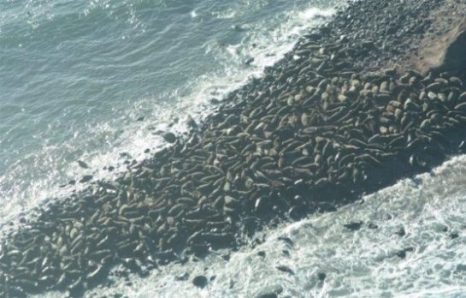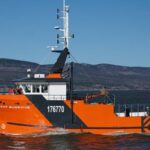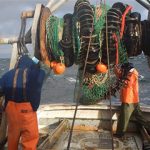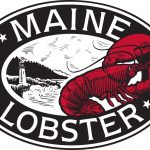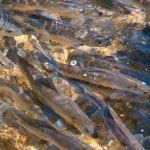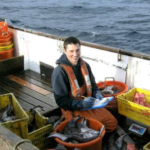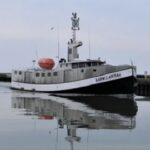Monthly Archives: September 2016
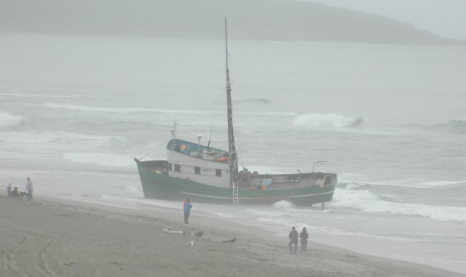
Coast Guard, partner agencies respond to fishing vessel aground near Salmon Creek Beach
The Coast Guard and partner agencies responded to a fishing vessel Sunday that ran aground in Bodega Bay, Calif. Coast Guard Sector San Francisco Command Center watchstanders were notified at 1:24 a.m., that a 54-foot fishing vessel, the Verna A II, had run soft aground near Salmon Creek Beach. When the master’s efforts to refloat his vessel were unsuccessful, a motor lifeboat crew was launched from Coast Guard Station Bodega Bay, along with two swimmers and a crew aboard a personal watercraft from Bodega Bay Fire. The master was removed from the vessel and transported to the beach due to safety concerns. The vessel is aground near freshwater wetlands neighboring the highway one bridge. The Oil Spill Liability Trust Fund has been opened for $50,000 and Parker Diving and Salvage has been hired to conduct fuel and oil removal operations. Link 08:41
Will Obama use the State Departments “Our Oceans” Conference to designate canyons and seamounts National Marine Monument?
 The third installment of the Our Ocean forum will convene in Washington, D.C., this week and the betting window is open on whether the Obama administration will use the event to announce the designation of new National Marine Monuments. No one — neither conservationists nor fishing stakeholders — claims to know exactly what will happen when the two-day, international event opens Thursday. But it has not escaped anyone’s attention that the Obama administration has used the same forum in the past to make similar announcements. The Obama administration’s decision not to use the Antiquities Act to designate any portion of Cashes Ledge as a monument validated fishing stakeholders and others who characterized the proposal — which originated with the Conservation Law Foundation, the Natural Resources Defense Council and Pew Charitable Trusts — as an end-run around the existing fisheries management system and wholly unnecessary given the existing protections already afforded the area. Read the story here 07:55
The third installment of the Our Ocean forum will convene in Washington, D.C., this week and the betting window is open on whether the Obama administration will use the event to announce the designation of new National Marine Monuments. No one — neither conservationists nor fishing stakeholders — claims to know exactly what will happen when the two-day, international event opens Thursday. But it has not escaped anyone’s attention that the Obama administration has used the same forum in the past to make similar announcements. The Obama administration’s decision not to use the Antiquities Act to designate any portion of Cashes Ledge as a monument validated fishing stakeholders and others who characterized the proposal — which originated with the Conservation Law Foundation, the Natural Resources Defense Council and Pew Charitable Trusts — as an end-run around the existing fisheries management system and wholly unnecessary given the existing protections already afforded the area. Read the story here 07:55
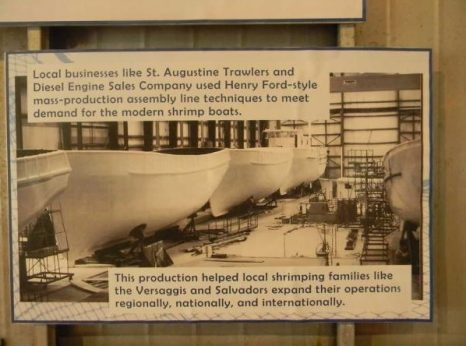
Former shrimp boat captain helps preserve the industry’s history
In 81 years, St. Augustine resident James Edwin “Ed” Long has witnessed a lot of change in his hometown. From 1951 until the 1990s, Long worked in the shrimping and shrimp boat building industry. Today, he is a keeper of that industry’s history and has worked long and hard to make sure it has received proper attention for its financial, global and community contributions. Thanks to Long’s efforts, future generations can experience this chapter in St. Augustine history. Long saved thousands of photos, boat models, stories and other ephemera, now preserved in the collections of the St. Augustine Lighthouse & Maritime Museum and part of an exhibit on the history of shrimping. Read the rest here with 15 images 18:33
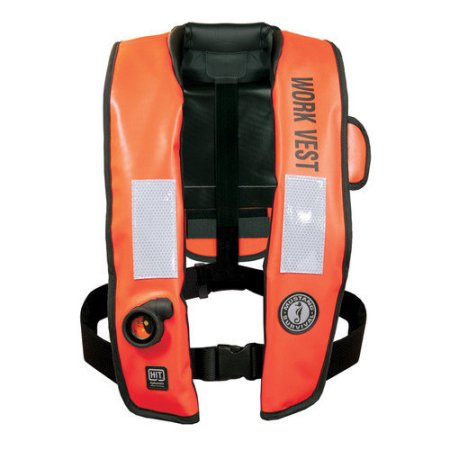
PFDs That Work – Personal Flotation Devices Prevent Fishermen Deaths
Researchers from the NIOSH Alaska Pacific Office asked commercial fishermen from 4 gear groups (crabbers, trawlers, longliners, gillnetters) to rate the comfort and acceptability of six modern personal flotation devices (PFDs). About 200 fishermen evaluated various PFDs for one month while working on deck so that wearable PFDs could be identified.1 Fishermen evaluated inflatable PFDs and foam PFDs that were either integrated into their rain gear or were worn in addition to raingear. Since deck work and fishing season varies for each gear group, fishermen had different preferences. Each gear group identified PFDs that are comfortable and easy to wear and are currently available for sale. The key to finding the proper PFD is to try on many to make sure they will work for the specific activities related to your type of fishing. Working on crowded decks and in close proximity to gear make it vitally important that a PFD not become a snagging hazard. Fishermen who work in colder weather may prefer a PFD with more foam padding for insulation against the weather. Read the rest here 14:53
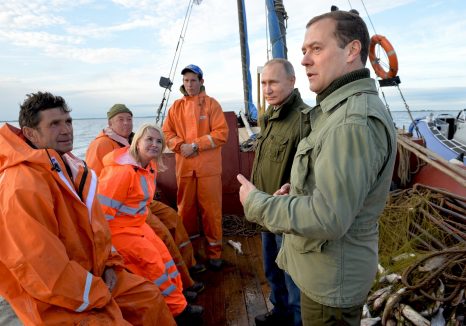
Russian President Putin, PM Medvedev Spend Weekend With Fishermen
Fishing Rod-builder Jay Johnstone adds a unique quality to fishing of all kinds
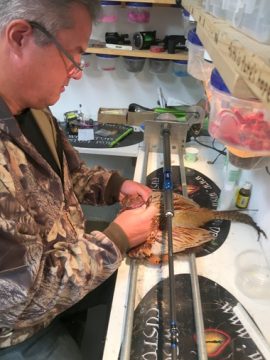 Jay Johnstone is a craftsman, an artist in a unique genre. Feathers are his medium, a fishing rod his canvas. Johnstone is a fishing-rod builder. “Everything from trout to tuna,” he said. But they’re not just any rod with fancy wrappings. His are each adorned with feathered bases where the rod enters the handle. His productions are not only aesthetic, they’re useful – and catching on as quickly and efficiently as they catch fish. Some anglers view fishing rods as simply tools, “sticks” to use as means to an end. At the other end of the boat, however, are those of us for whom a favorite rod is a friend, a close companion bonded by every fish it lands. His rods are used by several captains on the television reality series “Wicked Tuna”. One, Dave Marciano, is on his cell phone speed-dial. Read the story here 12:42
Jay Johnstone is a craftsman, an artist in a unique genre. Feathers are his medium, a fishing rod his canvas. Johnstone is a fishing-rod builder. “Everything from trout to tuna,” he said. But they’re not just any rod with fancy wrappings. His are each adorned with feathered bases where the rod enters the handle. His productions are not only aesthetic, they’re useful – and catching on as quickly and efficiently as they catch fish. Some anglers view fishing rods as simply tools, “sticks” to use as means to an end. At the other end of the boat, however, are those of us for whom a favorite rod is a friend, a close companion bonded by every fish it lands. His rods are used by several captains on the television reality series “Wicked Tuna”. One, Dave Marciano, is on his cell phone speed-dial. Read the story here 12:42
Gray seal population needs no protection – Mike Rice, South Wellfleet
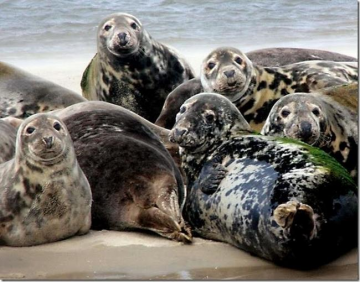 According to the International Union for Conservation of Nature, the giant panda is being taken off the endangered species list and reclassified as vulnerable. A nationwide Chinese census taken in 2014 found 1,864 giant pandas in the wild, up from 1,596 back in 2004. An estimated 40,000-plus gray seals alone call Monomoy Island off Chatham home. That leaves me wondering why the gray seal is still protected under the Marine Mammal Protection Act of 1972. As the gray seal population in Cape waters continues to boom, drawing more great white sharks to our area every summer, I’m left thinking the tourist industry here may soon join the fishing industry, and be classified as vulnerable, too. It’s time to de-list the gray seal from the Marine Mammal Protection Act of 1972. Link 08:49
According to the International Union for Conservation of Nature, the giant panda is being taken off the endangered species list and reclassified as vulnerable. A nationwide Chinese census taken in 2014 found 1,864 giant pandas in the wild, up from 1,596 back in 2004. An estimated 40,000-plus gray seals alone call Monomoy Island off Chatham home. That leaves me wondering why the gray seal is still protected under the Marine Mammal Protection Act of 1972. As the gray seal population in Cape waters continues to boom, drawing more great white sharks to our area every summer, I’m left thinking the tourist industry here may soon join the fishing industry, and be classified as vulnerable, too. It’s time to de-list the gray seal from the Marine Mammal Protection Act of 1972. Link 08:49
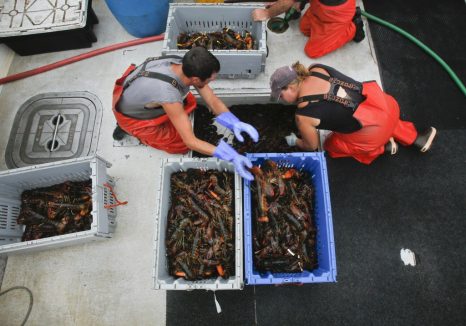
The ‘lobster capital of the world’ faces a crucial question
When Deer Isle lobsterman Jeff Eaton peers into one of his traps, he sees a lot more than snappers and selects, hard-shells and shedders. The part-time boat builder and avid lobster boat racer sees the heart of a $126 million regional economy that supports an even larger network of trap makers, bait dealers, marine supply shopkeepers and boat builders like himself. That trickle-down shadow economy has transformed the island, which used to be known best for the granite quarries that built New York and Washington, D.C.’s most iconic buildings, into a thriving lobster economy, now best known as the home to a 300-boat lobster fleet and the town of Stonington, the self-proclaimed lobster capital of the world. “Up here, the lobster business trickles down a lot further than just us fishermen,” Eaton said. “It feeds the whole economy.” Read the story here and view 15 images 08:13
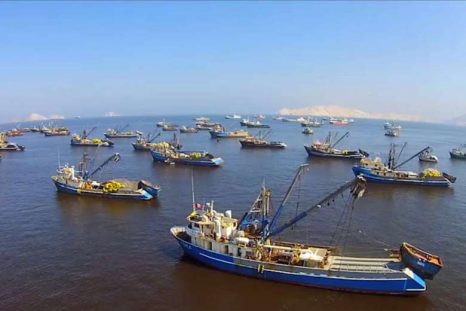
China Fishery against court appointing a US trustee
Beleaguered China Fishery has claimed that the appointment of a United States trustee would subject its bankruptcy estate to “greater costs than benefits” and result in a “severe destruction of value” for stakeholders. The Singapore-listed fishmeal supplier had filed for Chapter 11 protection in New York in June, along with more than 15 affiliates. Its parent firm, Hong Kong-based Pacific Andes International, also filed for bankruptcy in New York. China Fishery said the filing is aimed at stopping a fire sale of its assets, particularly its most valuable – the Peruvian fishmeal business that is valued at up to US$1.7 billion (S$2.3 billion). In bankruptcy papers obtained by The Straits Times, China Fishery argued that the appointment of a trustee would be “perceived as a mandate to comply with the lenders’ desire for a quick sale”. Further, “additional costs would compound” as a trustee would be “entitled to commissions of up to US$30 million for each US$1 billion of asset distributions”, it said in court papers filed on Sept 2. Read the story here 19:15
North Carolina company plans a large-scale test of its artificial lobster bait in Nova Scotia traps later this year
 Kepley Biosystems conducted a pilot study here last year and the small Greensboro, N.C., company aims to have local fishermen bait as many as 200 traps in November and December with its hockey puck-shaped tablets that, once immersed in water, mimic the smell of decomposing herring. “There’s definitely a lot of possibility to have this be a very, very disruptive technology that could bring in a lot of money,” Anthony Dellinger, the scientist who heads the company, told Local Xpress. Crustacean fishing is a $66-billion global market that now requires about 18 million tons of baitfish a year. That’s worth an estimated $20 billion annually, he said. The calcium-based tablets, dubbed OrganoBait, could eliminate the effort and resources it takes to catch bait, such as herring, that’s used to catch lobster, said Dellinger, who has a PhD in nanoscience. Read the story here 11:26
Kepley Biosystems conducted a pilot study here last year and the small Greensboro, N.C., company aims to have local fishermen bait as many as 200 traps in November and December with its hockey puck-shaped tablets that, once immersed in water, mimic the smell of decomposing herring. “There’s definitely a lot of possibility to have this be a very, very disruptive technology that could bring in a lot of money,” Anthony Dellinger, the scientist who heads the company, told Local Xpress. Crustacean fishing is a $66-billion global market that now requires about 18 million tons of baitfish a year. That’s worth an estimated $20 billion annually, he said. The calcium-based tablets, dubbed OrganoBait, could eliminate the effort and resources it takes to catch bait, such as herring, that’s used to catch lobster, said Dellinger, who has a PhD in nanoscience. Read the story here 11:26
Deadliest Catch Dungeness Cove – Meet Captain Kenny Ripka
 Tell me about your career. I’m a commercial fisherman. I’ve been doing this since I was 14 years old. It’ the only job I’ve ever had in my whole life. How did you get involved in the show? I was fishing shrimp in Westport Washington and I got a phone call from my dad. He said, “They’re thinking about shooting a ‘Deadliest Catch’ show here in Oregon. They found us, but we never thought we’d be on TV. It all started with a phone call. What can viewers expect to see? Viewers will see exactly what it’s like to fish crabs off the coast of Oregon. It’s highly intense and stressful. They’ll also see what it’s like to manage home life and fishing. And a lot of crappy weather! Read the rest of the interview here 10:47
Tell me about your career. I’m a commercial fisherman. I’ve been doing this since I was 14 years old. It’ the only job I’ve ever had in my whole life. How did you get involved in the show? I was fishing shrimp in Westport Washington and I got a phone call from my dad. He said, “They’re thinking about shooting a ‘Deadliest Catch’ show here in Oregon. They found us, but we never thought we’d be on TV. It all started with a phone call. What can viewers expect to see? Viewers will see exactly what it’s like to fish crabs off the coast of Oregon. It’s highly intense and stressful. They’ll also see what it’s like to manage home life and fishing. And a lot of crappy weather! Read the rest of the interview here 10:47
Swipe card system will help track Maine sea urchin fishery
 Maine’s 2016-2017 sea urchin season will be a repeat of last season in terms of the number of fishing days and daily landing limits. But state regulators are launching a new swipe card system to track the activity of harvesters and dealers. The Department of Marine Resources (DMR) hopes the system will create efficiencies for fishermen, dealers and DMR staff. They also hope it will support efforts to keep the fishery sustainable. By automating required weekly dealer reports, previously done on paper, “swipe cards reduce the chance of human error which can occur when transcribing landings information,” said Trisha Cheney, DMR resource management coordinator for sea urchins. Read the story here 10:08
Maine’s 2016-2017 sea urchin season will be a repeat of last season in terms of the number of fishing days and daily landing limits. But state regulators are launching a new swipe card system to track the activity of harvesters and dealers. The Department of Marine Resources (DMR) hopes the system will create efficiencies for fishermen, dealers and DMR staff. They also hope it will support efforts to keep the fishery sustainable. By automating required weekly dealer reports, previously done on paper, “swipe cards reduce the chance of human error which can occur when transcribing landings information,” said Trisha Cheney, DMR resource management coordinator for sea urchins. Read the story here 10:08
Bluefin tuna – ‘The biggest, baddest fish in the ocean’
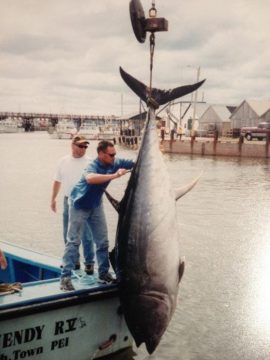 The love of the bluefin tuna runs deep in Jeff MacNeill. Captain Jeff, as he’s called, is the third generation in his family to fish for the giant bluefin. As long as he can remember, he has posed for photos next to the giant fish that have been hauled aboard a boat in what he calls “the battle.” “They’re so big, they’re so beautiful, they’re five times stronger than any other fish in the ocean,” said MacNeill. “It’s the biggest, baddest fish in the ocean and they’re right on our door step.” “It’s basically you’re hooking on to a Volkswagen is what you’re doing.” But it’s not all glory. MacNeill recalls many years ago when he went out for 28 days in a row without getting a bite.”I get emotional thinking about it, they’re just the greatest fish in the world. They are.” Read the story here, with more images 09:40
The love of the bluefin tuna runs deep in Jeff MacNeill. Captain Jeff, as he’s called, is the third generation in his family to fish for the giant bluefin. As long as he can remember, he has posed for photos next to the giant fish that have been hauled aboard a boat in what he calls “the battle.” “They’re so big, they’re so beautiful, they’re five times stronger than any other fish in the ocean,” said MacNeill. “It’s the biggest, baddest fish in the ocean and they’re right on our door step.” “It’s basically you’re hooking on to a Volkswagen is what you’re doing.” But it’s not all glory. MacNeill recalls many years ago when he went out for 28 days in a row without getting a bite.”I get emotional thinking about it, they’re just the greatest fish in the world. They are.” Read the story here, with more images 09:40
Furuno unveils new radar with Bird Mode feature
 Furuno introduced its new DRS6AX “X-Class” Radar, which it said brings a refined 6kW open array to NavNet TZtouch and TZtouch2. For fishermen, the company said the DRS6AX introduces a new “Bird Mode” that delivers bird detection performance to NavNet TZtouch or TZtouch2 display. Furuno said flocks of birds can easily be picked out at various ranges without manual tuning, with a tap of the Bird Mode feature. It is possible to discern the movement of individual birds within a flock utilizing Echo Trails. The maximum pulse length delivers 50 percent more “Power On Target” than previous DRS radars, the company said. Read the rest here 08:17
Furuno introduced its new DRS6AX “X-Class” Radar, which it said brings a refined 6kW open array to NavNet TZtouch and TZtouch2. For fishermen, the company said the DRS6AX introduces a new “Bird Mode” that delivers bird detection performance to NavNet TZtouch or TZtouch2 display. Furuno said flocks of birds can easily be picked out at various ranges without manual tuning, with a tap of the Bird Mode feature. It is possible to discern the movement of individual birds within a flock utilizing Echo Trails. The maximum pulse length delivers 50 percent more “Power On Target” than previous DRS radars, the company said. Read the rest here 08:17

State of New York finalizes safe harbor rules for commercial fishermen
New York has finalized guidelines for commercial fishing boats seeking safe harbor in storms and other adverse conditions, eight months after the state lost a court case against one East End fisherman because the rules weren’t in writing. The state Department of Environmental Conservation says the new safe harbor guidelines will give clarity to fishing boat captains faced with potential dangers at sea by defining the conditions under which they can seek permission to enter New York ports while on federally registered commercial fishing trips. The guidelines require captains to notify the DEC before entering port in the state to seek permission to enter. The DEC said the rules were welcomed by fishermen, but one local fishing advocate argued the guidelines are “toothless” because they don’t grant fishermen any rights. Read the story here 07:56
Bristol Bay total salmon catch #1 in 20 years, Value tops $156m
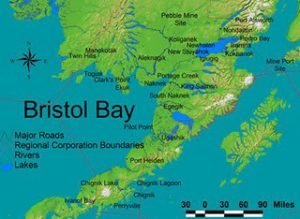 From Alaska Dept. of Fish and Game September 9, 2016 The following is an overview of the 2016 Bristol Bay commercial salmon season. All data are preliminary. The 2016 inshore Bristol Bay sockeye salmon run of 51.4 million fish ranks 2nd out of the last 20 years and was 46% above the 35.1 million average run for the same period. This year’s Bristol Bay sockeye salmon run was 10% above the preseason inshore forecast of 46.6 million fish. The Egegik,Nushagak, Togiak and Ugashik districts were higher than the preseason forecast while Naknek-Kvichak district was less than predicted. Read the rest here 19:04
From Alaska Dept. of Fish and Game September 9, 2016 The following is an overview of the 2016 Bristol Bay commercial salmon season. All data are preliminary. The 2016 inshore Bristol Bay sockeye salmon run of 51.4 million fish ranks 2nd out of the last 20 years and was 46% above the 35.1 million average run for the same period. This year’s Bristol Bay sockeye salmon run was 10% above the preseason inshore forecast of 46.6 million fish. The Egegik,Nushagak, Togiak and Ugashik districts were higher than the preseason forecast while Naknek-Kvichak district was less than predicted. Read the rest here 19:04
Oceana going overboard on fish fraud with “misleading hyperbole”, distorts its findings by design
 The National Fisheries Institute (NFI) is calling into question both the findings and motives of the latest fish fraud study by Oceana, a global environmental group. The action marks a break between the two groups since they previously were largely in sync with one another over the worldwide problem of fish fraud, which is where lesser-value species are marketed as higher-value ones. NFI claims that by finding 20 percent of all seafood mislabeled globally, Oceana’s latest report is both overstating the problem and unnecessarily calling for an expanded regulatory bureaucracy when enforcement of existing laws is all that is needed. NFI, a trade association representing the seafood industry with a core mission of sustainability, charges that the environmental group has turned to “misleading hyperbole.” “Oceana’s focus on the most often mislabeled species distorts its findings by design. It is a common technique that ironically perpetuates a fraud on the readers of these reports,” the NFI statement adds. Read the story here 16:56
The National Fisheries Institute (NFI) is calling into question both the findings and motives of the latest fish fraud study by Oceana, a global environmental group. The action marks a break between the two groups since they previously were largely in sync with one another over the worldwide problem of fish fraud, which is where lesser-value species are marketed as higher-value ones. NFI claims that by finding 20 percent of all seafood mislabeled globally, Oceana’s latest report is both overstating the problem and unnecessarily calling for an expanded regulatory bureaucracy when enforcement of existing laws is all that is needed. NFI, a trade association representing the seafood industry with a core mission of sustainability, charges that the environmental group has turned to “misleading hyperbole.” “Oceana’s focus on the most often mislabeled species distorts its findings by design. It is a common technique that ironically perpetuates a fraud on the readers of these reports,” the NFI statement adds. Read the story here 16:56
Fishing Illegally – Menakhem Ben-Yami
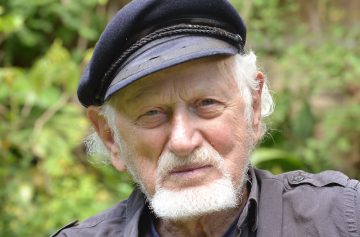 According to the EU, NOAA and other “regulators,” ‘Illegal, Unreported and Unregulated fishing (IUU) depletes fish stocks, destroys marine habitats, distorts competition, puts honest fishers at an unfair disadvantage, and weakens coastal communities, particularly in developing countries,’ etc., etc. The sundry of published documents, articles, and even learned papers, published not only in the fisheries-related, but also in the general press in recent years, are all bombarding us with IUU. If words could sink vessels, there’d be many more wrecks decorating the bottom of the sea. Read the rest here 16:21
According to the EU, NOAA and other “regulators,” ‘Illegal, Unreported and Unregulated fishing (IUU) depletes fish stocks, destroys marine habitats, distorts competition, puts honest fishers at an unfair disadvantage, and weakens coastal communities, particularly in developing countries,’ etc., etc. The sundry of published documents, articles, and even learned papers, published not only in the fisheries-related, but also in the general press in recent years, are all bombarding us with IUU. If words could sink vessels, there’d be many more wrecks decorating the bottom of the sea. Read the rest here 16:21
Can I repossess a boat without a recorded preferred ship mortgage?
 Q: I loaned $62,000 to a boat owner and required him to sign a security agreement in the form of a Preferred Ship Mortgage. The collateral is a 50-foot motor yacht that is documented with the Coast Guard and currently moored in a marina in Los Angeles Harbor. The note and the mortgage are signed by the debtor, but his signature is not notarized. He missed several payments and he is now clearly in default. How do I go about repossessing the boat and selling it to help pay what he owes me? A: Our reader may run into some problems with his planned repossession of the boat. This appears to be one of those cases where someone handles a complex process by himself without consulting a professional, and as a result he missed a few steps along the way. Read the rest of the answer here, and protect yourself! 13:32
Q: I loaned $62,000 to a boat owner and required him to sign a security agreement in the form of a Preferred Ship Mortgage. The collateral is a 50-foot motor yacht that is documented with the Coast Guard and currently moored in a marina in Los Angeles Harbor. The note and the mortgage are signed by the debtor, but his signature is not notarized. He missed several payments and he is now clearly in default. How do I go about repossessing the boat and selling it to help pay what he owes me? A: Our reader may run into some problems with his planned repossession of the boat. This appears to be one of those cases where someone handles a complex process by himself without consulting a professional, and as a result he missed a few steps along the way. Read the rest of the answer here, and protect yourself! 13:32
Fishing captain charged with repeatedly assaulting a crew member and threatening to kill him
 The skipper of a fishing vessel has been charged with repeatedly assaulting a crew member and threatening to kill him in waters near Kodiak last month. Kyle Mead, 39, of Anchorage, faces five counts of assault, three of them felonies, following an Aug. 26 incident aboard the fishing vessel Miss Destinee. All five counts are considered acts of domestic violence because both Mead and the crew member were living aboard the vessel at the time. According to an affidavit against Mead, written by trooper Brock Simmons, Mead reported an assault to Kodiak troopers by satellite phone at about 5 p.m. Aug. 26, saying that the crew member charged Mead, who had “defended himself.” Afterward, Mead said, he told the crew member to remain in his bunk as the Miss Destinee headed for Kodiak. “During his time on board, (Mead) had made several comments to (the victim) placing him in fear of physical injury,” Simmons wrote. “The defendant had told him, ‘We’re under maritime law out here and it would be easy to make you disappear.’ ” Read the story here 13:06
The skipper of a fishing vessel has been charged with repeatedly assaulting a crew member and threatening to kill him in waters near Kodiak last month. Kyle Mead, 39, of Anchorage, faces five counts of assault, three of them felonies, following an Aug. 26 incident aboard the fishing vessel Miss Destinee. All five counts are considered acts of domestic violence because both Mead and the crew member were living aboard the vessel at the time. According to an affidavit against Mead, written by trooper Brock Simmons, Mead reported an assault to Kodiak troopers by satellite phone at about 5 p.m. Aug. 26, saying that the crew member charged Mead, who had “defended himself.” Afterward, Mead said, he told the crew member to remain in his bunk as the Miss Destinee headed for Kodiak. “During his time on board, (Mead) had made several comments to (the victim) placing him in fear of physical injury,” Simmons wrote. “The defendant had told him, ‘We’re under maritime law out here and it would be easy to make you disappear.’ ” Read the story here 13:06
Lobster Advisory Council votes to close Maine’s last open zone
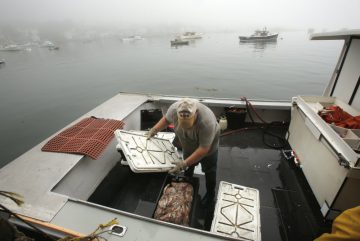 Local fishing authorities in Maine’s busiest lobster region say newcomers must wait for someone else to give up their license before they can set traps in local waters. The lobster council that oversees the area that includes Stonington and Vinalhaven, the top two lobster ports in Maine, voted 6-1 Thursday night to close the state’s last open lobster zone. The state’s other six regions already require apprentices who complete their training to wait, sometimes for as long as a decade, for others in their area to give up their licenses before they can fish. It is now up to Patrick Keliher, commissioner of the Maine Department of Marine Resources, to decide whether to implement the council’s vote, as well as adopt the council’s proposed one-in, one-out exit ratio. Read the story here 12:12
Local fishing authorities in Maine’s busiest lobster region say newcomers must wait for someone else to give up their license before they can set traps in local waters. The lobster council that oversees the area that includes Stonington and Vinalhaven, the top two lobster ports in Maine, voted 6-1 Thursday night to close the state’s last open lobster zone. The state’s other six regions already require apprentices who complete their training to wait, sometimes for as long as a decade, for others in their area to give up their licenses before they can fish. It is now up to Patrick Keliher, commissioner of the Maine Department of Marine Resources, to decide whether to implement the council’s vote, as well as adopt the council’s proposed one-in, one-out exit ratio. Read the story here 12:12
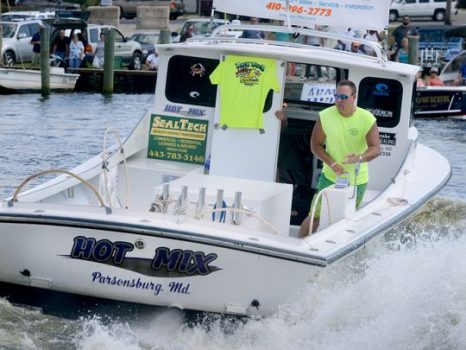
Be There! Saturday, Sept 10th – Brew River’s boat docking event a ‘rodeo on the water’
The ninth annual “Boat Dockin’ ” competition is set to take off in Salisbury this weekend, with a promise of a water rodeo that will showcase the expertise that only Eastern Shore watermen can offer. Erik “Flea” Emely, head of the “Chesapeake Cowboys,” who will be participating in the Saturday, Sept. 10, competition, says the long-running event is a personification of the area. “This really shows off exactly what the Eastern Shore waterman scene is about,” he said. The competition began in Crisfield decades ago, Emely said, but has recently spread across the Eastern Shore. Large boats versus smaller ones, single-manned vessels and team competitions will all be displayed at the event. All participants involved hold a commercial fishing or crabbing license, Emely said. Video, Read the story here 08:50
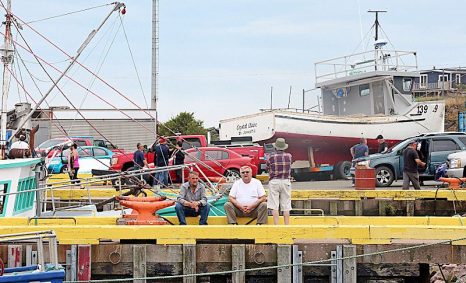
‘These are the risks that we take’
Walking the floor boards with worry and praying for a miracle. It’s a sadly repeated ritual in Newfoundland where the sea gives life and, just as swiftly, takes it away. “We live that life and that’s who we are,” said Johanna Ryan Guy, as the search for two of four men who went missing from a capsized fishing boat continued Thursday near St. John’s. The search was later changed to a recovery mission as hopes of finding the two remaining fishermen alive dwindled. Bodies of the other two men were recovered after the seven-metre craft was reported overturned Tuesday night near Cape Spear. All were from the close community of Shea Heights, where grieving residents say it’s beyond tragic that three generations of one family were on that boat. A team of investigators with the Transportation Safety Board (TSB) is now looking into the deadly incident. As in all maritime communities, dangers in the waters off Newfoundland are real and unpredictable. Read the story here 08:17
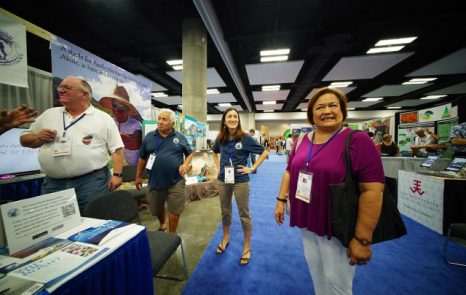
How the WPFMC and Kitty Simonds Crashed Conservation’s Biggest Event
Irreverent might be the best way to describe Kitty Simonds’ feelings about the International Union for Conservation of Nature’s World Conservation Congress, a 10-day event currently taking place at the Hawaii Convention Center. “It’s all about making money,” Simonds said as she looked dismissively at two preteens taking selfies with cardboard cut-outs of elephants and tigers at an environmental exhibition on the convention center floor. Simonds is the executive director of the Western Pacific Fishery Management Council — or Wespac, as it’s more commonly known — a quasi-governmental agency charged with monitoring Pacific fish stocks from Hawaii and American Samoa to Guam and the Northern Mariana Islands. She’s a highly contentious figure in conservation circles, which made her organization’s involvement in the world’s largest environmental conference all the more curious. Simond’s brazen attitude was on full display at the Hawaii Convention Center this week. The agency had it’s own exhibition booth alongside the likes of the Nature Conservancy and World Wildlife Fund. The exhibition stuck out, too. (Kudos to Kitty!) Read the story here 07:51
Trading Salmon for Almonds
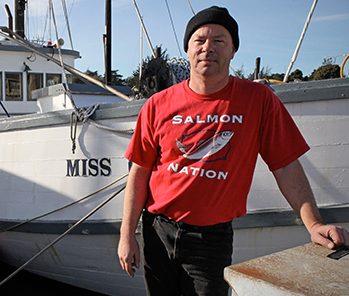 Northern California fishermen have endured an extremely difficult year. Fishery managers closed the entire commercial salmon fishing season for half of June and all of July in much of Northern California, and in general, ocean fishing has been poor the past few years off the California coast. The drought is to blame, along with excessive water diversions from the streams where Chinook salmon spawn. So it’s frustrating for commercial fishermen like Mike Hudson of Berkeley to hear that another part of the state’s food industry—almonds—is expecting a record crop in 2016. Almond farmers draw water from the same river systems in which Chinook salmon lay and fertilize their eggs, and to Hudson—a longtime critic of unsustainable agriculture, including growing thirsty crops like almonds in the dry San Joaquin Valley—it appears as though the farmer’s gain is his loss. Read the story here 18:31
Northern California fishermen have endured an extremely difficult year. Fishery managers closed the entire commercial salmon fishing season for half of June and all of July in much of Northern California, and in general, ocean fishing has been poor the past few years off the California coast. The drought is to blame, along with excessive water diversions from the streams where Chinook salmon spawn. So it’s frustrating for commercial fishermen like Mike Hudson of Berkeley to hear that another part of the state’s food industry—almonds—is expecting a record crop in 2016. Almond farmers draw water from the same river systems in which Chinook salmon lay and fertilize their eggs, and to Hudson—a longtime critic of unsustainable agriculture, including growing thirsty crops like almonds in the dry San Joaquin Valley—it appears as though the farmer’s gain is his loss. Read the story here 18:31
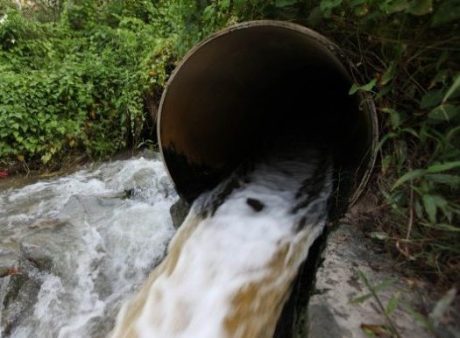
Have you heard? Nutrient pollution is changing sounds in the sea
Nutrient pollution emptying into seas from cities, towns and agricultural land is changing the sounds made by marine life – and potentially upsetting navigational cues for fish and other sea creatures, a new University of Adelaide study has found. Published online in the journal Landscape Ecology, the research found that marine ecosystems degraded by ‘eutrophication’, caused by run-off from adjacent land, are more silent than healthier comparable ecosystems. This marine ‘soundscape’ comes largely from the snapping of shrimps, but also the rasping of sea urchins and fish vocalisations. The researchers – PhD graduate Tullio Rossi, Associate Professor Ivan Nagelkerken and Professor Sean Connell from the University’s Environment Institute – studied kelp forests and seagrass beds in South Australia’s St Vincent’s Gulf, many of which have been impacted by excessive nutrients washing into the sea, particularly along the metropolitan coast of Adelaide. Read the rest here 17:31
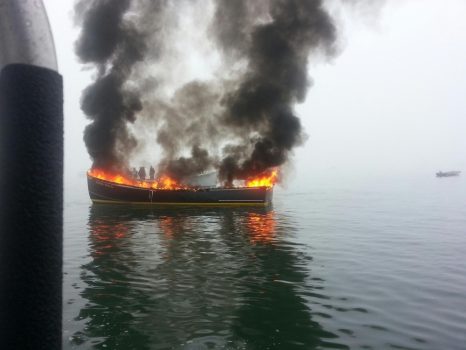
Coast Guard fights boat fire in Jonesport, Maine
A Coast Guard boat crew extinguished a boat fire Thursday off the coast of Jonesport, Maine. At about 6:12 a.m., watchstanders at Coast Guard Sector Northern New England received a call from the owner, who was on shore, that his 32-foot fishing vessel Bigger Dirls was on fire in Hopkins Point Marina. Station Jonesport launched a 29-foot response boat crew. They arrived on scene where the vessel was tied to a mooring ball and used their dewatering pump to begin fighting the fire. Jonesport Fire Department also arrived on scene and assisted in dousing the flames. When the fire was extinguished, the boat was towed by a good Samaritan to shore at Hopkins Point Marina. The cause of the boat fire is currently under investigation. Link 14:32
Maine: The Situation with bait Herring
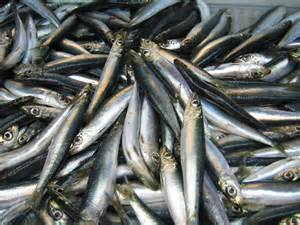 On a local radio station recently a commentator stated that herring stocks are overfished. Overfishing has led to the current shortage of herring for lobstermen’s use as bait, he continued. His statement was incorrect. Among the many fish species that call the Gulf of Maine home, Atlantic herring are one species that is doing quite well, thank you very much. In the opaque language of fisheries regulators, “Atlantic herring stocks are not overfished and overfishing is not occurring.” So why has herring availability become such an issue for lobstermen this summer? The migratory fish is the preferred bait for many Maine lobstermen and when there’s no herring available, lobstermen get a little testy. The problem lies not with the fish, who right now are congregating in spawning schools along the coast. The problem lies with the regulatory need to control what happens at sea, a desire that often conflicts with what is actually happening at sea. Read the story here 14:18
On a local radio station recently a commentator stated that herring stocks are overfished. Overfishing has led to the current shortage of herring for lobstermen’s use as bait, he continued. His statement was incorrect. Among the many fish species that call the Gulf of Maine home, Atlantic herring are one species that is doing quite well, thank you very much. In the opaque language of fisheries regulators, “Atlantic herring stocks are not overfished and overfishing is not occurring.” So why has herring availability become such an issue for lobstermen this summer? The migratory fish is the preferred bait for many Maine lobstermen and when there’s no herring available, lobstermen get a little testy. The problem lies not with the fish, who right now are congregating in spawning schools along the coast. The problem lies with the regulatory need to control what happens at sea, a desire that often conflicts with what is actually happening at sea. Read the story here 14:18
Murrells Inlet fundraiser set for Lost at Sea Memorial Saturday, Sept. 10th
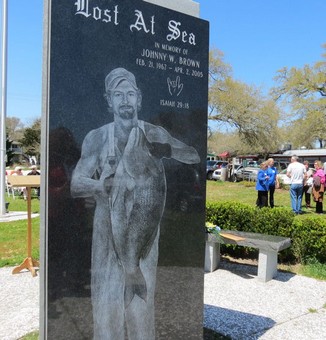 People who would like to support the Lost at Sea Memorial in Murrells Inlet will gather at the Big Beaver Bar for a fundraiser on Saturday, Sept. 10. The event, which will features food, live music, raffles, door prizes and a silent auction, will be held from 1 to 5 p.m. Admission is a suggested $10 donation. “This is a benefit to help the memorial and continue adding names as necessary,” said event organizer Gary Pew. “It is for a good local cause.” The Lost at Sea Memorial is located at Morse Park Landing in Murrells Inlet. He said he attended the last Lost at Sea Memorial service held in April with a friend who lost her son at sea. He found out that more funds are needed to maintain the monument and add names each year. According to the Lost at Sea Memorial website, it was established in April of 2005 by the family of Johnny W. Brown. He was a native of Horry County and a commercial fisherman out of Murrells Inlet. Read the story here 13:33
People who would like to support the Lost at Sea Memorial in Murrells Inlet will gather at the Big Beaver Bar for a fundraiser on Saturday, Sept. 10. The event, which will features food, live music, raffles, door prizes and a silent auction, will be held from 1 to 5 p.m. Admission is a suggested $10 donation. “This is a benefit to help the memorial and continue adding names as necessary,” said event organizer Gary Pew. “It is for a good local cause.” The Lost at Sea Memorial is located at Morse Park Landing in Murrells Inlet. He said he attended the last Lost at Sea Memorial service held in April with a friend who lost her son at sea. He found out that more funds are needed to maintain the monument and add names each year. According to the Lost at Sea Memorial website, it was established in April of 2005 by the family of Johnny W. Brown. He was a native of Horry County and a commercial fisherman out of Murrells Inlet. Read the story here 13:33



































